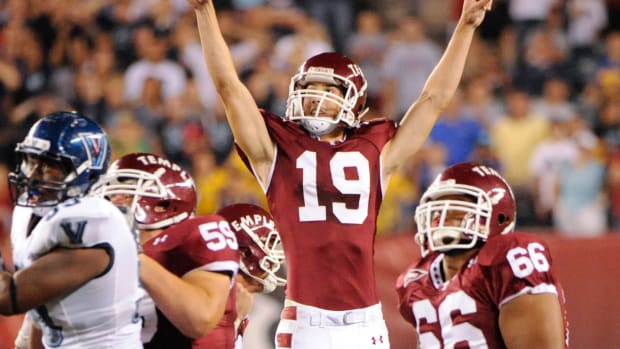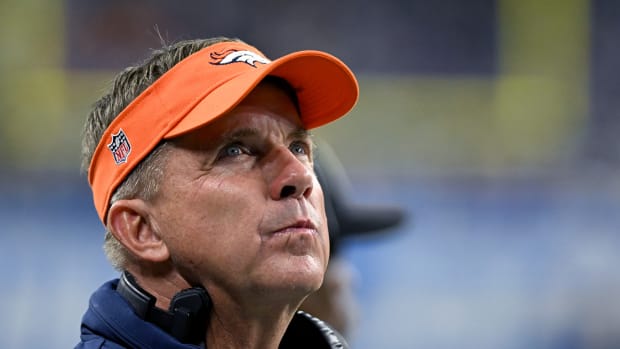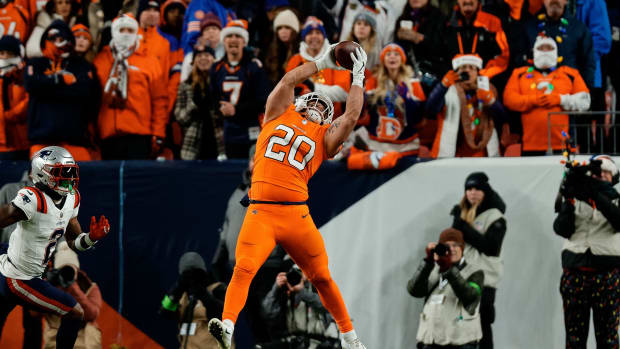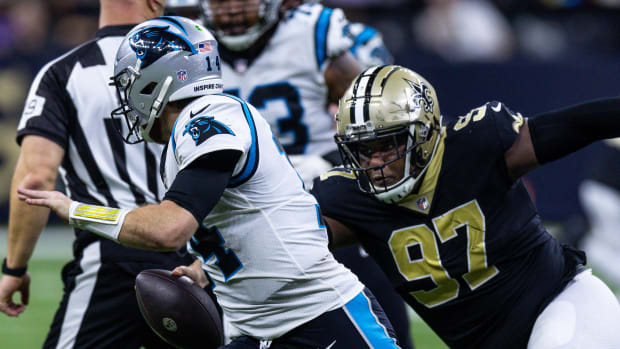Broncos 2020 Offseason Plan to Build the Nest Around Lock & Return to Competitive Form
Even though the Denver Broncos handily beat the Houston Texans with an offensive display that hasn’t been seen in many years, there is still a lot of work to be done by this team to get back on a competitive path. The Broncos are heading the right direction, and so long as they don’t falter, this team could be looking at a strong 2020 season.
If Denver sticks with it, dare I say, this could be a team able to compete for the playoffs next season.
In order for the Broncos to get there, there's still a lot of work to be done and roster maneuverings to manage. Before getting to what the Broncos need to do with their roster, first, let's analyze their coaching staff. Well, two coaches in particular.
Head coach Vic Fangio has figured out how to call the defensive signals from the sidelines, though he had a rough start to the season in this department. There are still issues with his lack of aggression, but as the season marches on, he seems to be getting a little more aggressive. Fangio's defense has issues, but a lot of that comes with the lack of talent and depth on the roster.
I have been very critical of offensive coordinator Rich Scangarello, but he deserves praise for the Week 14 game he called against the Houston Texans. The Broncos are a team ranked top-10 in most major offensive statistical categories in the first quarter, with yards per rush being the only one not in the top-10, which came in at 17th.
The statistical categories are total yards (4th), points (tied 5th), touchdowns (tied 5th), yards per play (8th), pards per pass play (7th), yards per rush (17th), plays that gain 20-plus yards (tied 2nd), first downs (tied 6th), and third-down conversion percentage (8th).
The Broncos start off games well, and there is a reason for that. Teams typically have a script of 15 plays, or a script for the first two offensive series, for them to run, which is typically all of the first quarter. This script is often designed with input from all coaches and even some players. It is a collaboration based on what the coaches and players see on film and areas of the opponent they feel like they can exploit.
Once teams are off their script, it falls on the offensive coordinator to call plays based on what he is seeing from the opponent and what he thinks will work. This takes place from, say, the second quarter on. To say that Denver has struggled once Scangarello gets off the script is an understatement. In those same categories for the last three-quarters of the game, the Broncos rank 32nd in every single one except for rush yards per play where they rank 14th.
So getting more consistent and aggressive play-calling will be beneficial for the Broncos, especially on the offensive side of the ball. Denver needs these two coaches to work out because this team can’t turn over the coaching staff again.
Besides the coaching staff, the other and very obvious part of getting back to contention is through building the roster. Thankfully for the Broncos, they don’t have much dead weight they have to trim down.
Denver has plenty of cap space, and are projected to have 12 picks in the 2020 NFL Draft with five of them in the top-100. Here are the roster steps the Broncos can take to get back to playoff contention and build that nest around Drew Lock.
Players to Cut
There are only two players on the Broncos roster that really need to be cut — Ronald Leary and Joe Flacco. Some can argue that Denver should move on from Todd Davis and Jeff Heuerman, but Davis has had a good year and there is a lot of uncertainty with the Broncos' tight end position behind Noah Fant.
The Broncos restructured Flacco’s contract prior to the season. It was done to free up some extra cap space for the year and to actually get the Broncos under the salary cap since they were over it by about $2 million. There was no extra money added to Flacco’s contract, so he still got the same amount of money, it was just paid out differently.
Because of the restructure, cutting Flacco will result in a $13.6 million dead cap hit and free up $10.05 million in cap space. Since the CBA is poised to expire, there is no June-1st cut designation next year to help alleviate the dead money for the 2020 season.
Even though this looks bad, Denver can roll-over their unused cap space from this season to 2020, a large portion of which came from restructuring Flacco’s deal, so it all balances out.
As for Leary, his medical history just has been against him. He has missed time each season he's been in Denver, and he isn’t the best fit scheme-wise for the Broncos. Letting go of Leary, the Broncos can free up $8.5M in salary-cap space, while only taking on $875K in dead money.
Rolling over all of their unused salary cap space from this season and cutting these two players would give the Broncos a projected $85M in cap space to maneuver with. With so many free agents pending for the Broncos, that space gives the team wiggle room.
Players to let Walk
There are a total of 13 unrestricted free agents that the Broncos have to decide on in the spring. The Broncos need to let most of them walk.
Even though the Broncos will have money, some of these free agents are likely going to cost more than they're worth and the Broncos need to avoid spending money on players who don't give them a return on investment. Others just aren’t good enough to really focus on keeping around.
CB Chris Harris, Jr. will be the hardest free agent to let walk. He has been a staple for the Broncos defense for many years, but this season has shown that he has lost a step. With him likely looking for a max contract, he just isn’t worth it for the Broncos.
The next free agent is one of two that I went back and forth on keeping. DL Shelby Harris has had a very solid year for the Broncos, but the inconsistency in his game is maddening. He hasn’t taken a step forward as a pass rusher, at least not to the level the Broncos had hoped he would.
There is also the issue of his run defense, which is even more inconsistent than his ability to get after quarterbacks. Harris is likely looking at a big deal on the open market and the Broncos should let him walk as a result.
Center Connor McGovern is the second player I went back and forth keeping. After seeing what Cody Whitehair got in his extension with Chicago, McGovern will likely be looking for something similar and that is just way too much for a middle-of-the-pack center. The max for McGovern should be $8M on an average per year basis, but he could crack double digits.
S Will Parks, DL Adam Gotsis, RB Devontae Booker, RB Theo Riddick, and LB Corey Nelson all should be allowed to walk. They either have no role on the team, aren’t part of the future, or just aren't good enough to make an effort to retain.
Players to Re-sign
While Denver should let all those players walk, there are a few the team should keep. S Justin Simmons highlights that group, and the reason is simple. Simmons has been one of the best safeties in the NFL and is half of one of the best duos in the NFL.
DL Derek Wolfe is another that should be brought back. He has been the best Broncos' defensive linemen this season, but the value needs to match after a season-ending injury. Wolfe is a good fit in this defense and in his role, and we know he wants to stay in Denver.
LS Casey Kreiter and LB Jeremiah Attaochu are two more players worth keeping — for the right price. Attaochu has been a great find at outside linebacker since Bradley Chubb got hurt, and he could be a good depth piece moving forward. As for Kreiter, long snappers are cheap but he is a very good long snapper.
LB Joe Jones is a restricted free agent. The original round tender is too expensive for Jones, but he is worth keeping. Despite his issues on special teams this season, Jones is a good third-phase player. Extending him for a year on a very cheap deal to compete is worth it.
RFAs to Tender
That brings me to restricted free agents. The Broncos have many, and none of them are worth more than an original round tender. With some of these players, it is cheaper than what they would otherwise get, and for others, it isn’t much more than what they should garner on the open market. The RFAs are QB Brandon Allen, OL Elijah Wilkinson, DT Mike Purcell, and CB De’Vante Bausby.
All exclusive rights free agents should be retained as they provide very cheap depth options. Over The Cap lists OT Jake Rodgers, WR/PR Diontae Spencer, DB Trey Marshall, CB Davontae Harris, WR Tim Patrick, and S Dymonte Thomas. Cheap labor is cheap labor.
Attacking Free Agency
This is a pretty strong year for free agency, and the Broncos should have a good amount of money. Of course, that depends on what it costs to retain Wolfe and Simmons (in this scenario). Also, letting all those other free agents walk, Denver shouldn’t go heavy on unrestricted free agents. There is one soon-to-be free agent that stands out if his current team doesn’t retain him.
Brandon Scherff is an excellent offensive guard in the NFL, and with cutting Leary, the Broncos will need a new right guard. Scherff has experience in the scheme, or at least a variation of it, after spending so many years in Washington.
This season, Scherff has allowed 10 total pressures, with one sack, while facing off against some tough interior defensive linemen. He has also played well as a run blocker and would be a much better fit than Leary in the Broncos' scheme. Washington is looking at a coaching change, so that could play a big part in Scherff being allowed to walk.
To utilize the compensatory pick formula to its fullest, the Broncos should be looking at players who get cut from their current contract. I explain more of the value and strategy in pursuing street free agents in the video above, but CB Prince Amukamara, WR Taylor Gabriel, and DE Calais Campbell are all being heavily talked about as potential veteran cap casualties.
Amukamara is having a bit of a rough year, but there is a lot of talk that he isn’t fitting in with the scheme Chuck Pagano brought to Chicago in Fangio's place. Amukamara is allowing a 111.3 QB rating in coverage this season, but in 2018 under Fangio, it was 81.9, 89.1 in 2017 and 108.8 in 2016. Of Broncos cornerbacks who have played more than 150 snaps this season, none are under 100 QB rating when targeted.
As for Gabriel, he can be a dynamic receiver and would bring speed to the Broncos offense. He has been a big disappointment for the Bears, so he won’t be expensive. At the very least, it would give the Broncos a speedy, dynamic weapon on their offense that is missing. Gabriel played in Atlanta for Kyle Shanahan, so he is familiar with the scheme.
As for Campbell, he is a Colorado native whom the Broncos almost signed a couple of years ago. He has been playing great for the Jaguars, but they are tight with the salary cap and will have to cut some talent to give them wiggle room. Campbell is 33 years old and the Jaguars can free up $15M of salary cap by letting him go.
Entering Week 14 of the season, Von Miller had 60 total pressures, while Campbell had 59. Campbell has been a force this year, and Denver can shell out some money to land him. Since he would be cut in this scenario, he wouldn’t count against the compensatory pick formula.
Just for the record, the closest Broncos defensive linemen in pressures was Wolfe with 22. That's a massive drop-off from Campbell's 59. He also has 29 stops and would upgrade what the Broncos have in Shelby Harris as a more consistent and reliable pass rusher and run defender.
Even though the Broncos are projected to have nearly $85M in cap space after cutting Flacco and Leary, signing Scherff, Simmons, Wolfe, Campbell, Amukamara, Gabriel, Kreiter, Attaochu and all the tenders would take up a lot of that money. With Chris Harris, Jr., Shelby Harris and Connor McGovern being allowed to walk, Scherff would only cancel one out in the compensatory pick formula, and that could lead to the Broncos garnering two compensatory picks in the third/fourth round in the 2021 draft.
Speaking of the draft, that would be the final part to getting this turned around for next year.
NFL Draft
The Broncos are projected to have 12 picks at this point, counting 2020 projected compensatory picks. Denver has additional picks from Pittsburgh, San Francisco and Washington.
Round 1: Andrew Thomas, OT, Georgia
Denver currently sits at No. 11 in the draft order, so how is it Thomas is here? For starters, Tristan Wirfs and Jedrick Wills have really risen up boards, while Thomas has taken a small tumble. Speaking to people in and around the NFL, there has been a lot of talk Thomas has a good chance of falling out of the top-10. Now, this is being said in December, so a lot can still change.
Since that is the recent chatter, it's what I am going with. Having spent many hours watching his tape, it is easy to see why Thomas may fall on draft day some. There just doesn’t seem to be as high of a ceiling as there is with Wills and Wirfs. Thomas has good technique as a run blocker and pass blocker.
Denver currently has Garett Bolles as their left tackle and Thomas is probably more reliable than Bolles without ever having taken a snap in the NFL. The Broncos have a massive need to fix their offensive line, and it starts with the left tackle position. Dalton Risner was a good first step at left guard, and in this scenario, Brandon Scherff was added at right guard. With a focus on wanting to run the ball, Thomas adds a third piece to the line to do just that.
Round 2: Jeff Gladney, CB, TCU
In his career at TCU, Gladney has a nose for the ball shown by 37 pass deflections and five interceptions. He is natural playing off coverage and reading the play in front of him. The athleticism is off the charts and shows the potential to be a shutdown corner at the NFL level.
Gladney has been a fast riser this college season. He has shown improvements to multiple areas of his game. His footwork is cleaner, technique at the catch point improved and is tougher at the catch point. Watching him, it is obvious how he fits into the Broncos defense, plus he is a sound tackler.
Round 3: Leki Fotu, DL, Utah
The Broncos have to find someone to fill that Akiem Hicks role on the defensive line. In this scenario, the Broncos brought Derek Wolfe back and brought in Calais Campbell. With Dre’Mont Jones as depth, the only missing piece is the big beefy middle. Mike Purcell is having a solid year, but Denver can upgrade.
Fotu is that beefy body, and he can bring it as a pass rusher. He has long arms and is a physical specimen. Entering the season, there was a concern about his pad level, but this year there has been a lot of improvement in Fotu. Pairing him with Bill Kollar and in Vic Fangio’s scheme can make him a dangerous piece.
Round 3: Brandon Aiyuk, WR, Arizona State
In this scenario, the Broncos added speedy Taylor Gabriel, but he has been a disappointment so adding another speedy weapon for the offense is high up there on the list. Aiyuk is a great athlete and has tremendous speed to take the top off of defenses. His route running isn’t the best, but he shows promise that can be worked on.
Aiyuk would really open up the Broncos offense because of the speed he brings to the table. Drawing safeties deep would help open up Noah Fant and Courtland Sutton. Even if he doesn’t draw the safety, the Broncos have a quarterback that can attack the deep part of the field with his arm strength.
Round 3: Clyde Edwards-Helaire, RB, LSU
Royce Freeman has been a letdown for the Broncos, but that doesn’t mean they need to give up on him. What the Broncos do need to do, however, is to add competition to the running back position and replace Devontae Booker with someone more capable.
Do you want a running back that can do it all? Well, Edwards-Helaire can. He is a good runner with a good burst to get to the hole quickly. His hands as a receiver are clean, and he runs pretty good routes. He can return kicks and is a capable blocker. Denver would add a capable and versatile running back to their running back room who can be the bell-cow and allow them to use Phillip Lindsay to really be the killing blow, instead of relying on him as the bell-cow.
Round 4: Cesar Ruiz, C, Michigan
A multiple-year starter at center for the Wolverines. Ruiz has the traits and tools desired in a center for the NFL level. Denver runs a scheme that is a good fit for Ruiz as he moves very well for being a bigger center. He has some technical issues that can be cleaned up, but Mike Munchak and Chris Kuper should be able to handle that.
Round 4: Dele Harding, LB, Illinois
A player really flying under the radar, at least in the public eye. In his first three years, Harding notched a total of 82 tackles, but this year he is nearing 150. He is very quick sideline-to-sideline and operates excellently in zone coverage. Harding has intercepted three passes, forced two fumbles, recovered two fumbles, and scored two touchdowns. Depth at linebacker would be boosted and gives the Broncos a future replacement for Todd Davis.
Round 5: Myles Dorn, S, North Carolina
Denver let Will Parks walk in this scenario, so they need someone to step up as the No. 3 safety. Dorn can play multiple roles, which adds value to the Broncos with the defense Vic Fangio runs. He is a safety that isn’t the best athlete, but has an excellent diagnosis of plays, and trusts his instincts which often gets him into good positioning.
Round 6: Matt Bushman, TE, BYU
The Broncos could use someone to step up at tight end. Jake Butt can’t stay on the field. Jeff Heuerman is just a guy. Troy Fumagalli has ye to develop. Austin Fort is an unknown. Andrew Beck has shown some promise, but will it continue? Bushman is a well-rounded tight end that has been asked to block multiple ways and is very capable. He also has also good athleticism as a receiver, which would make Bushman a great pairing with Noah Fant.
Round 7: Scott Frantz, OT, Kansas State
Talent-wise, Frantz is worth a late third-round pick, but he is likely to fall because he is an openly gay player. There are many who have issues with that, both with fans, players, and team personnel. Having Dalton Risner, who was a teammate with Frantz, would help. All that really matters is if Frantz can play, and he can play. Depth on their offensive line, particularly offensive tackle, would be a huge boost.
Round 7: James Lynch, DL, Baylor
This is probably the best defensive linemen you have never heard of. Lynch has 10.5 sacks for the Baylor Bears this season and looks very similar to Derek Wolfe when he came out of Cincinnati. With the depth on their defensive line taking a hit, Lynch with Fotu and Campbell keeps the defensive line a strength of the defense, while upgrading the unit overall.
Round 7: Tyler Huntley, QB, Utah
It wasn’t the best three games from Brandon Allen when he was the starter, and he showed the concerns around his game that have seen him bounce around the NFL. Denver could use some more competition for their backup spot besides just Brett Rypien. Tyler Huntley is a great fit in the scheme and plays at Utah which is sort of a pipeline for Broncos players.
Follow Erick on Twitter @ErickTrickel and @MileHighHuddle.




